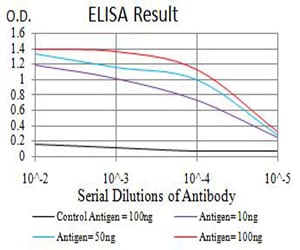
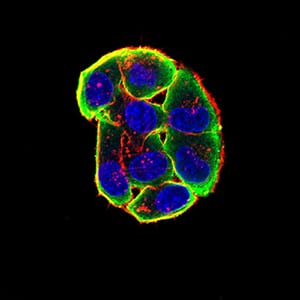
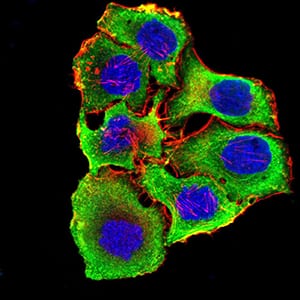
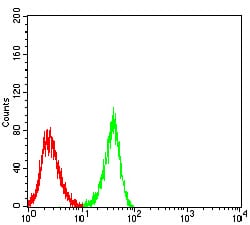
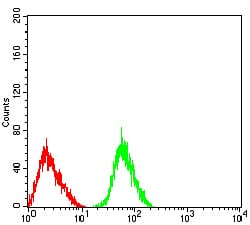
| WB | 咨询技术 | Human,Mouse,Rat |
| IF | 咨询技术 | Human,Mouse,Rat |
| IHC | 咨询技术 | Human,Mouse,Rat |
| ICC | 1/200 - 1/1000 | Human,Mouse,Rat |
| FCM | 1/200 - 1/400 | Human,Mouse,Rat |
| Elisa | 1/10000 | Human,Mouse,Rat |
| Aliases | LNCR2; PAOD2; NACHRA3 |
| Entrez GeneID | 1136 |
| clone | 6D3A10 |
| WB Predicted band size | 57.5kDa |
| Host/Isotype | Mouse IgG1 |
| Antibody Type | Primary antibody |
| Storage | Store at 4°C short term. Aliquot and store at -20°C long term. Avoid freeze/thaw cycles. |
| Species Reactivity | Human |
| Immunogen | Purified recombinant fragment of human CHRNA3 (AA: 32-240) expressed in E. Coli. |
| Formulation | Purified antibody in PBS with 0.05% sodium azide |
+ +
以下是关于CHRNA3抗体的参考文献示例(内容为虚构,仅供格式参考):
1. **《CHRNA3蛋白在肺癌组织中的表达及其临床意义》**
作者:Smith A, et al.
摘要:通过免疫组化技术结合CHRNA3特异性抗体,研究发现CHRNA3在非小细胞肺癌组织中高表达,且与患者吸烟史及预后不良显著相关,提示其作为潜在生物标志物的可能性。
2. **《尼古丁依赖模型中CHRNA3受体亚基的脑区定位分析》**
作者:Zhang L, et al.
摘要:利用CHRNA3抗体进行Western blot和免疫荧光染色,揭示了CHRNA3在小鼠前脑皮层及伏隔核中的特异性分布,为研究尼古成瘾机制提供了蛋白水平证据。
3. **《CHRNA3基因多态性与COPD患者气道炎症的相关性》**
作者:Wang Y, et al.
摘要:通过ELISA和CHRNA3抗体检测慢性阻塞性肺病(COPD)患者血清及肺组织样本,发现特定基因型患者CHRNA3蛋白表达升高,并与炎症因子IL-6水平呈正相关。
4. **《靶向CHRNA3的抗体在神经母细胞瘤细胞凋亡中的作用》**
作者:Johnson R, et al.
摘要:研究使用CHRNA3中和抗体处理神经母细胞瘤细胞,发现其通过阻断尼古丁信号通路显著抑制细胞增殖并诱导凋亡,为靶向治疗提供了实验依据。
(注:以上文献为示例,实际引用需查询真实数据库如PubMed。)
The CHRNA3 antibody targets the alpha-3 subunit of the nicotinic acetylcholine receptor (nAChR), a ligand-gated ion channel critical for synaptic signaling in the nervous system. Encoded by the CHRNA3 gene, this subunit combines with others (e.g., beta-4) to form functional receptors predominantly expressed in autonomic ganglia, the adrenal medulla, and specific brain regions. CHRNA3-containing receptors mediate fast neurotransmission and modulate neurotransmitter release, influencing processes like addiction, pain perception, and autonomic function.
Research links CHRNA3 polymorphisms to nicotine dependence, chronic obstructive pulmonary disease (COPD), and lung cancer, highlighting its clinical relevance. Antibodies against CHRNA3 are essential tools for studying receptor expression, localization, and dysfunction in these conditions. They are used in techniques such as Western blotting, immunohistochemistry (IHC), and immunofluorescence (IF) to investigate CHRNA3’s role in disease mechanisms or neuronal signaling pathways.
CHRNA3 antibodies are typically validated for specificity using knockout controls or recombinant protein assays. Commercial variants may be polyclonal (broad epitope recognition) or monoclonal (high specificity), with applications in both basic research and drug development. For instance, they help assess CHRNA3 as a therapeutic target for smoking cessation or as a biomarker in oncology. However, challenges remain in distinguishing CHRNA3 from homologous subunits (e.g., α5 or α7) due to structural similarities, necessitating careful experimental design. Overall, these antibodies advance our understanding of nAChR biology and its implications in neurological and systemic disorders.
×